Carbon Nanotubes
| Carbon nanotubes (CNTs), especially single-walled CNTs (SWNTs), are a representative nanomaterial which has various unique properties in addition to a diameter as small as 1 nm and a length as long as 1 mm and longer. Various applications have been proposed and extensively researched, however, practical applications are very limited due to the undeveloped fabrication processes. I am trying to fundamentally understand the way how the carbon nanotubes grow, and to fabricate them simply by self-organization processes. I am collaborating with Prof. Maruyama at Department of Mechanical Engineering. |
 Rapid Growth of Nanotubes. High resolution image is here. |
- Original Catalyst Screening Method: Combinatorial Masked Deposition, CMD
In general, CNTs grow by precipitation of carbon from metal nanoparticles of a few nanometers. Nanoparticles can be suspended in the gas-phase or supported on subtrates, and in either case, the key is how to realize a small particle size at the elevated temperatures needed for CNT growth.
Even when supported on substrates, catalyst metals diffuse over the substrate surfaces and nanoparticles get coarsened at high temperatures. Not by suppressing this phenomenon but by utilizing it, particles can be grown up to the desired size and utilized as catalyst. By depositing catalyst metals on substrates by sputtering through a physical filter, gradient thickness profiles of catalyst metals can be simply formed [20]. When CVD is carried out on thse "catalyst libraries", CNTs grow up at the regions where nanoparticles of suitable sizes are spontaneously formed [31]. In addition, orthogonal thickness profiles of binary components, can be formed by using a physical filter with a slit, enables the optimization of the amount and composition of binary components on a single substrate [34].
This method is quite simple but effective, and thus, I hope many people to use it. If you have any questions, please feel free to e-mail me.
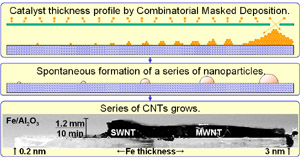
Catalyst screening by our CMD method.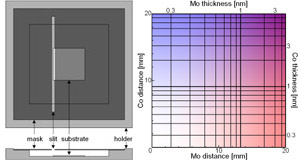
CMD for binary systems.
Mass Production by Fluidized Bed: Movie
ref.: [20] Appl. Surf. Sci. 225, 372 (2004). [31] Appl. Phys. Lett. 86, 173106 (2005). [34] Carbon 44, 1414 (2006). - Basics of catalytic growth of carbon nanotubes
By using the CMD method, the optimum nominal thickness was found to be as small as 0.1 nm for Co catalyst on SiO2 in efficiently growing high-quality SWNTs from ethanol [31]. Ultra-thin Co layer below one atomic layer yielded 2-nm-sized Co nanoparticles at an areal density of 1x1016/ m2. SWNTs growth was realized also by Ni catalyst, which had been believed to grow MWNTs rather than SWNTs when supported on substrates [35]. Catalyst metals had been too thick to grow SWNTs in the previous works. Fundamental understanding of phenomena enables us to reduce the amount of catalyst with confidence even when the catalysts do not work well.
Co-Mo/SiO2 catalyst is known effective in growing SWNTs from CO or ethanol, but different values are reported for the optimum Co/Mo composition. The CMD method was applied and the vertically aligned SWNT (VA-SWNT) forests were reproduced [34]. Recently, several conditions for the amount/composition of Co/Mo were found reactive in growing VA-SWNTs. Reproduction of the "supergrowth" method, which a number of research groups all over the world failed, was also realized and the catalytic role of Al2O3 supports was found to be the key for the rapid growth [37]. We have just started developing a novel catalyst in which the catalytic function is divided into elemental roles and a different site is designed for each role.
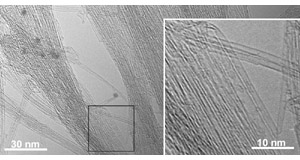
High-quality SWNTs by alcohol CVD.
Rapid growth of SWNTs (2-3 mm/ 30 min)
ref.: [31] Appl. Phys. Lett. 86, 173106 (2005). [34] Carbon 44, 1414 (2006). [35] Chem. Phys. Lett. 428, 381 (2006). [37] Jpn. J. Appl. Phys. 46, L399 (2007) (Express Letter). - "Customized" Production of Carbon Nanotubes and Practical Device Applications
Candidate applications are mapped degree of structural control and the added value of devices below.
To realize high-end application such as field-effect transistors (FETs) in integrated circuits, nanotubes need to be SWNTs with controlled chirality, and need to be precisely positioned at a large scale. Such precise controls of individual SWNTs are still major challenges. We are making continuous efforts in technological development such as for chirality-selective production of SWNTs.
To realize applications such as polymer composites and electrodes of batteries/capacitors, breakthrough is needed both in the cost and scale of nanotube production. We are now designing and developing a practical reactors based on chemical engineering to "upgrade" the rapid growth explained above to mass production.
Electronic/electric devices such as via-filling in integrated circuits, field-emitters for displays, and transparent electrodes for displays and solar cells can be placed in between. They do not require such precise controls of individual nanotubes and mass production of nanotubes. Instead, how to control their ensemble structure and how to realize them at a large area uniformly at a high throughput become important. The flexibility nature of CNTs with narrow diameters cause bundling of CNTs, and by utilizing this phenomenon rather than suppressing it, various ensemble structures will be simply fabricated through self-organization processes. From the viewpoints of structural control and production cost, these applications should be the nearest target for practical use of SWNTs.
CNTs have a large variety, and thus development of the production process customized for each application should be crucial to realize practical use of CNTs. Collaborative projects with private companies have been started.
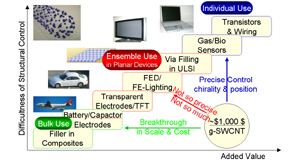
Map of applications of CNTs.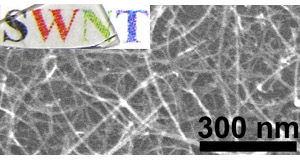
Controlled growth of SWNT networks for transparent electrodes.
Basics of Thin Film Growth & Applications to Information Devices and Solar Cells.
Physical vapor deposition (PVD) method, in which films are deposited from atoms onto substrates, and chemical vapor deposition (CVD) method, in which films are deposited through chemical reacitons of molecular precursors, are widely used in practical fabrication of devices. These methods are usually used to form "films" on substrates, but at the very initial stage of deposition, nanoparticles sometimes form at a high areal density. Various nanostructures spontaneously form depending on film thickness, types of materials, and deposition conditions. If these spontaneous processes were fundamentally understood and utilized, nanostructured materials for application can be fabricated by simple ways.- Fabrication of FePt magnetic nanoparticles for perpendicular magnetic recording media.
The continuing demand for increased high-density information storage is making nanostructural control crucial. For example, to achieve a recording density of 1 Tbit/inch2, one bit must be stored within an area of 25 nm2. FePt is being extensively studied as a promising candidate for the next generation magnetic recording material owing to its excellent magnetic property. To be practically used, FePt should have well-controlled structure at a multi-scale as listed below:
- Atomic scale: L10-ordering & vertical c-axis orientation.
- Nanometer scale: particle size of 3-10 nm & isolation among particles
- Macroscopic scale: inch-scale homogeneity & fabrication on inexpensive substrates.
We recently proposed and developed a novel approach coupling non-epitaxial growth with epitaxial growth, which can satisfy all of those requirements simultaneously [32].
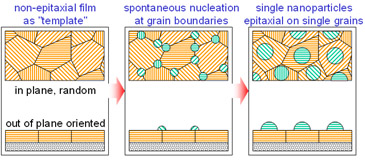
Concept of "local-epitaxy on non-epitaxial films".
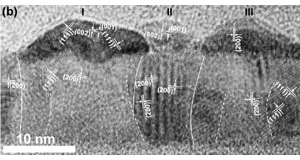
c-Axis oriented, coercive L10-FePt nanoparticles
formed by conventional sputtering apparatus.
ref.: [32] Jpn. J. Appl. Phys. 44, 7957 (2005). - Fabrication of metal lines and silicide electrodes of several tens nanometers in electronic devices.
Metal and silicide films are important as lines and electrodes in electronic devices such as integrated circuits. We are trying to understand the way how these polycrystalline films form and to control their microstructures for practical applications in devices. For example, the size of vias in ULSI, which have to be filled with metals, is continuouly shrinking down to several tens nanometers. When Cu is supplied from outside of the vias, Cu tends to grow at their entrance (rate process). But with a deeper thinking, for the underlayer on which Cu wet well, Cu can be more stabilized inside the vias than outside (equilibrium). In this case, the tinier the vias are, the easier they are filled. Our final goal is to end the endless development challenge in minitualization. - Low-cost, large-scale fabrication process of monocrystalline silicon thin films for solar cells.
Epitaxial growth, in which crystalline films grow keeping specific orientation with substrates, is often utilized for control of crystal structures at the atomic scale. This phenomenon occurs at a large rate and a large scale at elevated temperatures. By utilizing this phenomenon, we are trying to make a breakthrough for the large-scale installation of solar cells.
Solar cells are one of the promising candidates realizing clean and renewable energy systems. Crystalline-silicon type is the current major out of the various types of solar cells owing to its balanced properties among cost, power generation efficiency, lifetime, safety, abundance in natural resources, and so on. However, it is still needed to reduce the production cost to less than half and to increase the production volume by a factor of 2-3 orders to make solar cells to have an impact for the power-supply system. Both the cost reduction and production expansion is limited by the high purity silicon, which is the off-specification products of the semiconductor industry. Both problems can be simultaneously solved by substituting monocrystalline silicon thin films (around 10 um thick) for thick monocrystalline/polycrystalline silicon wafers, and we are now developing a novel process comprised of Rapid Vapor Deposition (RVD) and Epitaxial Lift-Off (ELO) methods.
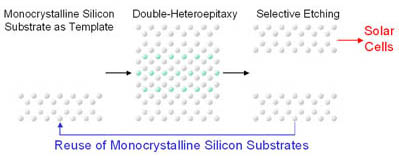
Concept of ELO: Copying monocrystalline wafer
into monocrystalline thin films for multiple times.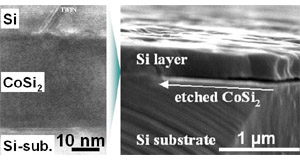
Example: Si/CoSi2/Si double heteroepitaxial structure
& selective etching of CoSi2 sacrificial layer.
Structuring knowledge on materials processing.
In these decades, human beings have encountered fundamental difficulty due to the gap between the complexity of the problems encountered and the subdivision of our knowledge base. A person finds it difficult to grasp the whole of an issue because only a small aspect of the issue is native to his (her) specific field. This is the case of current materials technology, which covers a very wide range of knowledge including fabrication processes, materials structures, materials properties and functions, and applications. To solve this problem, we have to reuse existing knowledge elements efficiently, by connecting proper elements correctly with each other. We have been making such efforts in the following national projects:- "Controlling abnormal structure in materials processing" project ('96-'00).
Expert System for Controlling Material Structure (in Japanese) - "Structuring knowledge of materials technology" project in "materials nanotechnology" program ('01-'04, '05-'06).
Nanomateria center (in Japanese)
Structured Knowledge Platform for Materials Nanotechnology (in Japanese) - "Establishment of networked knowledge system with structured knowledge for future scientific frontier" project ('01-'05).